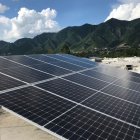Solar panels raise average temperature in cities, report finds
A study published in the journal Nature indicated that solar panels on urban buildings, particularly on rooftops, can have complex effects on the local thermal environment.

Solar Panels
Installing photovoltaic solar panels on rooftops throughout a city could raise temperatures during the day and lower them at night, a study revealed. The findings, published recently in Nature Cities, highlighted that urban temperatures could increase during the day by up to 1.5 °C during peak summer periods and decrease during the night by up to 0.6 °C in cities such as Kolkata.
Solar panel temperatures can reach up to 70°C during peak sunshine hours.
The research was led by the University of Calcutta's Ansar Khan along with UNSW Sydney Scientia Professor Mattheos Santamouris. For the study, mesoscale (weather system) simulations were used due to the absence of observational data available for rooftop solar photovoltaic panels (RPVSP) to model their impact on local weather conditions at the city scale.
The research team analyzed the impact of the panels under different coverage scenarios in Kolkata, India. They also conducted city-specific sensitivity studies (Sydney, Austin, Athens, and Brussels) to compare their findings with those in Kolkata.
"In Sydney, city-scale RPVSP deployment at the local district scale increased daytime air temperature by 1.5 °C while reducing it by 2.7 °C at night," the study explained.
In that regard, Nature indicated that solar panels on urban buildings, particularly on rooftops, can have complex effects on the local thermal environment. When installed on roofs, they absorb a significant amount of solar energy, converting some of it into electricity but also generating heat in the process.
Similarly, Professor Santamouris noted that a linear relationship was found to exist between temperature increase and the percentage of roofs covered with photovoltaic panels. "Under the maximum scenario of 100 per cent coverage during the peak summer period, our data shows that RPVSPs lead to a significant temperature increase during the day,” he said.
Estimates also show that in Sydney, nearly 40% of the electricity produced by the panels is used to offset the impact of overheating on additional cooling load, primarily air conditioning.
The research highlighted that it is imperative to thoroughly analyze the impact of the implementation of solar panels at city scale in various parts of the world. They have been massively promoted worldwide.
Furthermore, the researchers explained that, in their view, the findings can fuel policy debates and lead to redesigning policies for the implementation of the panels in cities.
"By addressing overheating issues and advocating for advanced RPVSP technologies and efficient cooling strategies, we aim to promote sustainable urban development practices and enhance the understanding of RPVSP deployment’s broader impacts," the study highlighted.
One of the solutions put forward by the research is that cool roof materials could be used. It also proposes other heat sinks, such as vegetation on roofs.
Meanwhile, governments have been promoting solar panels. The Biden-Harris administration announced that it would provide at least $7 billion in federal grants for solar energy.
The information was released by the Environmental Protection Agency (EPA), which also unveiled 60 selectees under the Greenhouse Gas Reduction Fund grant competition to deliver solar power to more than 900,000 homes.
Biden's decision came despite reports also revealing a major problem with the expansion of renewable energy because of the amount of waste generated by solar panels and wind turbine blades.
RECOMMENDATION






















